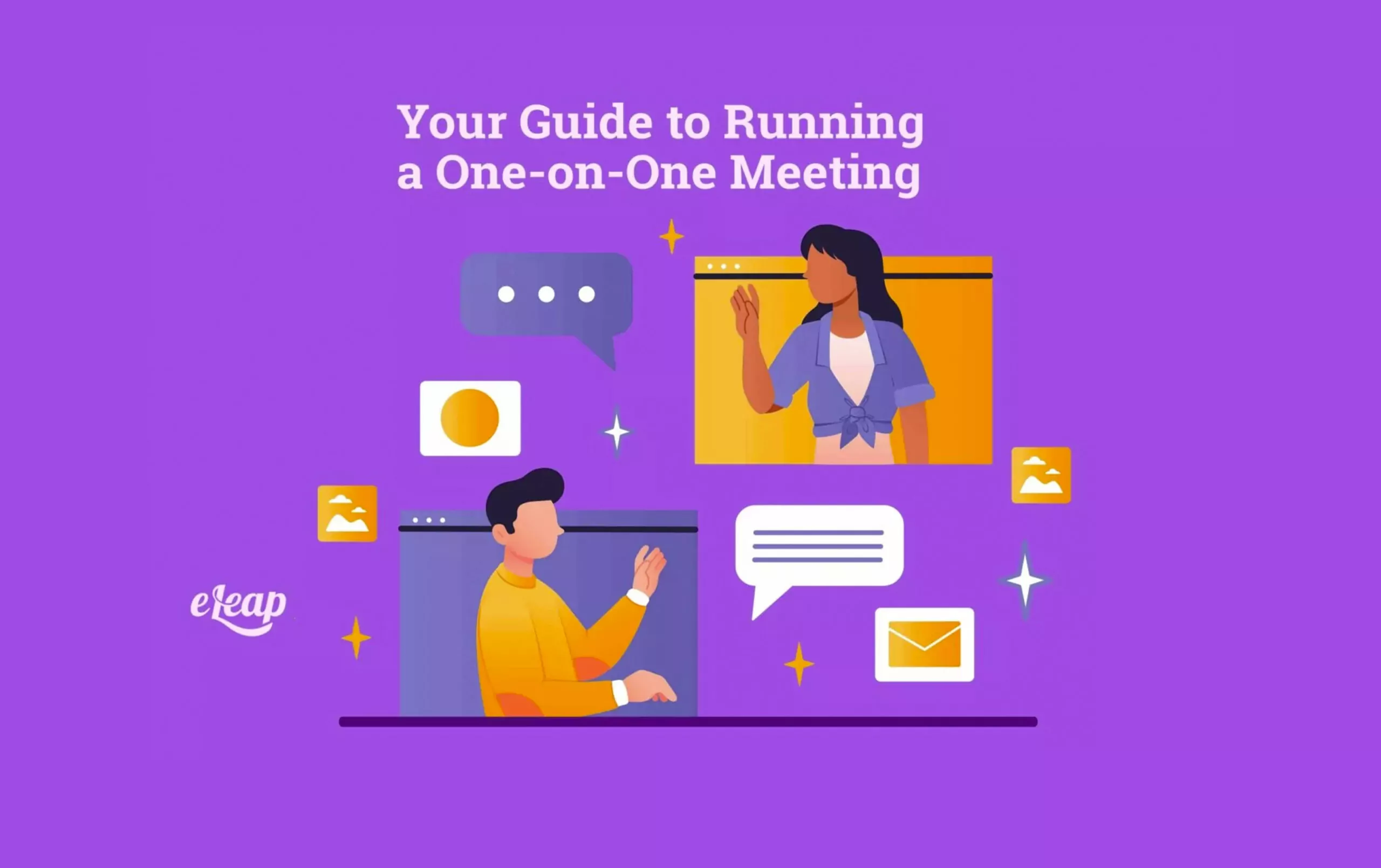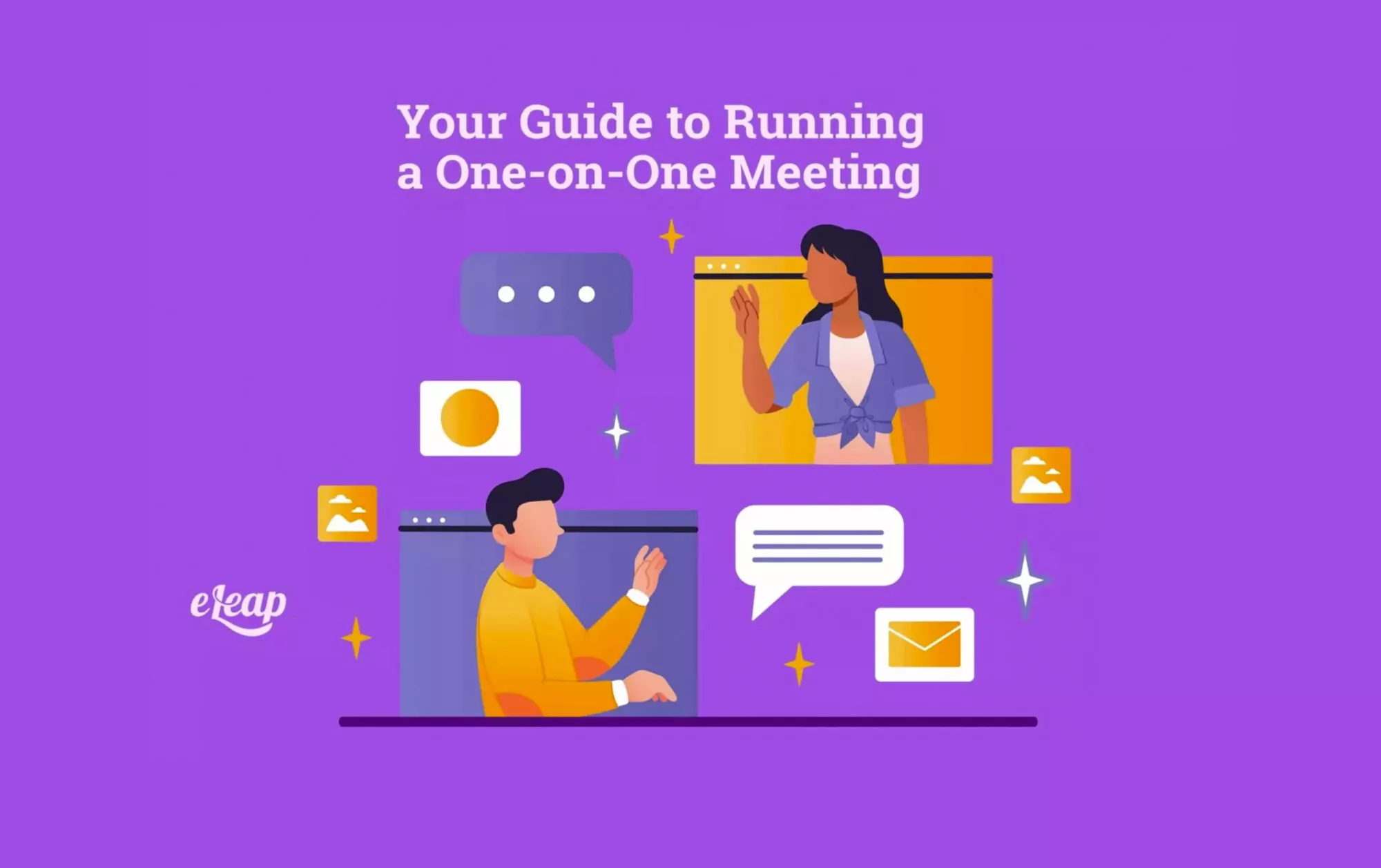Your Guide to Running a One-on-One Meeting

A one-on-one meeting might just be what you need to improve your managerial game. Want to do more in terms of employee development and performance management? Not sure how to do that? There’s good news.

Managers and leaders today have access to far more tools than old-school annual performance reviews (and more effective tools, too). One of those is the one-on-one meeting. Not sure how these work or how to conduct one? We’ll give you all the information you’ll need.
What Is a One-on-One Meeting?
Let’s start with the basics. What’s a one-on-one meeting in the first place? These meetings are important additions to the manager’s performance management toolbox. They’re less formal than official performance reviews, but they’re more involved than real-time feedback sessions.
One-on-one meetings are just what they sound like – meetings between you and the employee in question. No one else is involved. They take place as frequently as necessary and provide some very important benefits, including:
- Creating solutions to day-to-day problems
- Helping employees learn how to create strategies for success
- Showing employees that you are engaged and committed
- Course correcting
Of course, you’re probably still wondering a few things. Like what format should a one-on-one meeting take? What expectations should you set? What kinds of goals should be used? How often should you have these meetings? Let’s explore the topic in greater detail.
Finding the Right One-on-One Meeting Frequency
Communication frequency is one key to effectiveness. However, it can be challenging to find the right frequency, particularly when you’re balancing other responsibilities. It’s all too easy to get bogged down in your normal day-to-day responsibilities and before you know it, the chance to have a one-on-one meeting with a team member is gone for that day.
Interestingly, one of most employees’ common complaints is a lack of communication from their managers and other leaders. This includes positive feedback, as well as negative feedback. It makes sense, too. How can you be expected to perform well if you’re never told when you’re doing things right or doing them wrong?
So, when does a busy manager shoehorn one-on-one meetings into the mix? First, let’s address the mentality that these meetings are somehow “extra” or unnecessary. Manager-employee communication is the foundation of a successful business, and you must take the time to communicate with those you manage.
In terms of frequency, the ideal is to have a one-on-one meeting with each employee every single day. Of course, that’s not particularly realistic. It might be fine if you have a team of two, but what if you’re managing a team of 15 or 20 people? When would you fit in your other responsibilities?
There is no one-size-fits-all solution to one-on-one meeting frequency. What works for one team may not work for another. The goal is to make sure that you’re meeting with enough frequency that you can provide timely feedback to employees and that they’re able to communicate concerns to you. Perhaps the best option is to start with once per month or once every two weeks and then strive to move that to once per week.
Go ahead and plan these well in advance, too. Use a calendar tool to record meeting dates and times and then share those with your employees so that everyone knows who’s meeting with you and when. Make sure you only cancel those meetings when it’s necessary. Not only is that frustrating for the employee, but frequent cancellations show that you don’t value the one-on-one meeting format or the opportunity to communicate in greater depth with your team.
Setting Expectations for a One-on-One Meeting
Both managers and employees need to go into the one-on-one meeting with the right expectations. For managers, it can be difficult to internalize the point of these meetings – it’s all about the employee and not at all about you.
One-on-one meetings are the employee’s chance to talk about anything and everything that matters pertaining to their work life. They run the meeting and set the agenda. They direct the flow of conversation and the topics that you’ll touch on.
With that being said, you as a manager must provide some structure and guidance. You can set expectations on what to discuss by asking questions and guiding the employee to provide feedback. Follow these tips to help ensure that you’re able to set the right expectations for these important meetings:
- Ask employees to be prepared – By asking your employees to create their own agenda based on work matters that affect them most, you help ensure that you’re able to hit the ground running and avoid wasting time.
- Ask preparatory questions the day before – By asking your employee one or more of the following questions at least a day before the meeting, you help set everything in motion and provide them with the potential structure for the meeting. What questions should you consider asking? Here are a few examples:
- Is there anything specific that we should discuss in the meeting tomorrow?
- How do you feel your other team members are doing?
- How has the situation we discussed last time changed?
- What challenges are you facing these days?
- What accomplishments/victories have you had since our last meeting?
- Remind employees of the importance of the one-on-one meeting – Your one-on-ones should be almost sacred. They should not be used to discuss anything that might be done via email or text chat.
- Touch on previous issues – Use your one-on-one meeting time to explore past issues and how the employee is handling those today. This can include touching base on any action plans devised and implemented based on feedback from past meetings.
What Format Should a One-on-One Meeting Follow?
We’ve touched on frequency and expectations for a one-on-one meeting, and now we need to explore format options. As you probably imagine, the format is based on several factors, including frequency and employee expectations. Other factors that play a role here include the time allotted, the things being discussed, and more.
When we talk about format, we’re not discussing flow or content. We’re talking about where the meeting is held, the importance of taking notes, and the like. For instance, instead of having a one-on-one in the office, shake things up and go somewhere else. You can grab a coffee, head to a nearby park, or just sit and enjoy the sunshine while you talk. The point is to make the meeting both memorable and out of the ordinary by changing the scenery.
Here are some other important tips to help with the format of your one-on-one meetings:
- Take notes – Taking notes shows the employee that you are engaged and take what they are saying seriously.
- Follow up – Taking notes is not enough. You need to follow up on notes from previous meetings and find out how things have changed.
- Illustrate growth – Use your notes and observation to highlight how the employee has grown and developed over time. This shows that you are paying attention, but it can also boost confidence.
- Encourage professional development – Throughout your one-on-ones, make sure you encourage each employee to develop professional skills and competencies for their current role and help them move forward in their careers.
Goal Setting for a One-on-One Meeting
Each one-on-one meeting is an opportunity to set goals and move employees forward. However, goal setting must be handled correctly. Every one-on-one meeting should have relationship-driven, employee-oriented goals. They should not be business oriented. Remember, this is all about them.
Setting those goals requires asking the right questions and responding thoughtfully, though. Using check-in questions can help do that. It can also empower employees and build their confidence in themselves. For instance, you can ask about their plans and priorities between now and the next one-on-one meeting. You might ask about challenges they face and how you can help them with those. You can also ask about their current focus and if it will continue through the next week.
With the right goals, it’s possible to help employees grow, overcome hurdles, and move the entire business forward.
In Conclusion
Every one-on-one meeting is an opportunity to help an employee grow and thrive. These meetings are all about them, after all. They’re not about the business, except secondarily. Managers should use these meetings to help identify challenges that employees are facing and create solutions to them, while simultaneously encouraging employees to create long-term strategies that help prevent those and similar issues over time.
Finally, every one-on-one meeting should feed into relevant, specific, attainable goals. Those need to be employee-specific and should tie into long-term strategies for professional development, as well as for business success. The one-on-one meeting format might be relatively new for many managers, but the benefits it brings cannot be dismissed. It’s a critical tool in your toolbox and one that can encourage real change and improvement in employees, teams, and entire departments.
The eLeaP continuous performance management system provides organizations with powerful options to attract and retain high caliber team members.